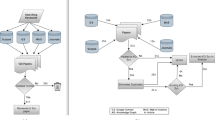Abstract
Sub-ontology, as the name implies, is a subset of an ontology tailored for a specific domain. Large-scale ontology data can be optimized by extracting the required sub-ontology. Sub-ontology extraction that reflects the user requirements is one method of addressing the issue. Here, sub-ontology extraction methods are called sub-ontology optimization schemes. In this paper, we develop a visual view for users to adopt sub-ontology extraction methods with a particular aim of providing users a front-end tool to perform a particular sub-ontology extraction. Likewise, we construct a Semantic Grid prototype environment to extract the sub-ontology and conducted preliminary evaluation through illustrations using the UMLS Semantic Network. Functional evaluations provided promising results to pursue further experiments and studies on the problem issue.





























Similar content being viewed by others
References
RDF (2009). http://www.w3.org/RDF/. Accessed August 2009.
OWL (2009). http://www.w3.org/TR/owl-features/. Accessed August 2009.
Wouters, C. (2005). A formalization and application of ontology extraction. PhD thesis, La Trobe University, Melbourne, Australia.
Bhatt, M., Wouters, C., Flahive, A., Rahayu, J. W., & Taniar, D. (2004). Semantic completeness in sub-ontology extraction using distributed methods. In Lecture notes in computer science: Vol. 3045, Part III. Proc. international conference on computational science and its applications (pp. 508–517). Berlin: Springer.
Flahive, A. (2008). Tailoring large domain ontologies in the semantic grid environment. PhD Thesis, La Trobe University, Australia.
UMLSSN (2009). http://semanticnetwork.nlm.nih.gov/. Accessed August 2009.
Flahive, A., Rahayu, J. W., Taniar, D., & Apduhan, B. O. (2005). A distributed ontology framework in the Semantic Grid environment. In Proc. of 19th international conference on advanced information networking and applications (pp. 193–196). Washington: IEEE Computer Society.
Flahive, A., Apduhan, B. O., Rahayu, J. W., & Taniar, D. (2006). Large scale ontology tailoring and simulation in the semantic grid environment. International Journal of Metadata, Semantics and Ontologies, 1(4), 265–281.
Flahive, A., Taniar, D., Rahayu, J. W., & Apduhan, B. O. (2009). Ontology tailoring in the Semantic Grid. Computer Standards & Interfaces, 31(5), 870–885.
Caralt, J. C. (2004). Ontology-driven information systems: pruning and refactoring of ontologies. In Doctoral symposium of the 7th international conference on the unified modeling language, Lisbon.
Lau, R. Y. K., Hao, J. X., Tang, M., & Zhou, X. (2007). Towards context-sensitive domain ontology extraction. In HICSS 2007 (p. 60).
Bhatt, M., Rahayu, W. J., Soni, S. P., & Wouters, C. (2007). OntoMove: a knowledge based framework for semantic requirement profiling and resource acquisition. In Proc. of 2007 Australian software engineering conference (pp. 137–146).
Bhatt, M., Flahive, A., Wouters, C., Rahayu, J. W., & Taniar, D. (2006). MOVE: a distributed framework for materialized ontology view extraction. Algorithmica, 45(3), 457–481.
Lloret, J., Garcia, M., Thomas, J., & Sendra, S. (2011). A group-based architecture for grids. Telecommunications Systems, 46(2), 117–133.
de Mello, R. F., Andrade, J. A., Senger, L. J., & Yang, L. T. (2008). Grid job scheduling using route with Genetic Algorithm support. Telecommunications Systems, 38(3–4), 147–160.
Acknowledgements
This work was supported by the Japan Society for the Promotion of Science Grants-in-Aid for Scientific Research, 21500087, 24500100.
Author information
Authors and Affiliations
Corresponding author
Rights and permissions
About this article
Cite this article
Uchibayashi, T., Apduhan, B.O. & Shiratori, N. A domain specific sub-ontology derivation end-user tool for the Semantic Grid. Telecommun Syst 55, 125–135 (2014). https://doi.org/10.1007/s11235-013-9757-3
Published:
Issue Date:
DOI: https://doi.org/10.1007/s11235-013-9757-3




